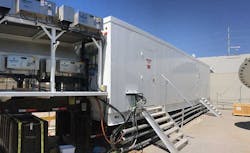Executive Insights: Gary Niederpruem of Vertiv
The Data Center Frontier Executive Roundtable features insights from industry executives with lengthy experience in the data center industry. Here’s a look at the insights from Gary Niederpruem of Vertiv.
GARY NIEDERPRUEM, Vertiv
Gary Niederpruem, chief strategy and development officer at Vertiv, is responsible for leading the organization’s marketing, strategy and M&A functions. Gary has more than 20 years of experience in harmonizing market trends, engaging customers and setting corporate-wide and business unit strategies to align to the market. Prior to joining Vertiv, Gary held a variety of P&L and product management leadership roles at Emerson and Danaher, including general manager of the integrated modular solutions business and vice president of product management. In 2014, he was named vice president of global marketing for Emerson Network Power and in mid-2016 he assumed oversight for the strategy function, serving as executive vice president, marketing and strategy. Gary attended John Carroll University where he received a bachelor’s degree in marketing and logistics. He also has a master’s degree in business from the University of Notre Dame.
Here’s the full text of Gary Niederpruem’s insights from our Executive Roundtable:
Data Center Frontier: As digital transformation gains momentum, enterprises are managing more data in more places. How will the explosive growth of data (“data gravity”) impact the growth and geography of digital infrastructure in 2020?
Gary Niederpruem: As digitalization continues to advance, the availability of digital infrastructure close to where data is being generated and consumed will enable new applications that use that data to create richer user experiences and improve business productivity and efficiency. This is the driver behind the growth in edge computing we are seeing today.
When you analyze current and emerging edge use cases, as we did at Vertiv, commonalities emerge in the areas of data management, latency and availability. Those commonalities enabled us to define edge archetypes that encompass multiple use cases. For example, while distributing HD video and supporting smart manufacturing are very different use cases, they share the common challenge of managing high volumes of data. Similarly, smart retail and augmented reality share the challenge of optimizing latency for human use of technology. As enterprises refine their strategies to capitalize on the opportunities digitalization represents, we will see compute and storage continuing to go where the data is through edge deployments.
Data Center Frontier: There’s a lot of buzz about 5G wireless. What is the likely impact of the 5G rollout on the data center industry, and when will we see it begin to drive meaningful growth?
Gary Niederpruem: 5G will serve as an accelerator of edge computing. It will both drive new edge deployments and enable new edge use cases. As 5G coverage expands, edge use cases that are currently bandwidth- or latency-limited will have those limitations removed. We see 5G beginning to ramp up this year and driving meaningful growth in edge computing over the next three years.
“As enterprises refine their strategies to capitalize on the opportunities digitalization represents, we will see compute and storage continuing to go where the data is through edge deployments.”
Gary Niederpruem, Vertiv
Data Center Frontier: Last year several studies indicated that rack density level is increasing. How might the growing use of artificial intelligence and edge computing impact rack density and the world of data center cooling?
Gary Niederpruem: What we are seeing from our customers is that average rack densities aren’t rising dramatically for many operators. But in select applications, such as AI, extremely high densities are becoming more common. That’s created an interesting environment where you have some users with relatively stable densities and some with densities that weren’t even practical 10 years ago. This is occurring both within the core data center and on the edge.
From a cooling perspective, operators need the ability to efficiently cool facilities that support standard density racks (5 kW to 8 kW), high density racks (30 kW and higher), and have some mix of both. Key to accomplishing that is being able to adapt the right cooling technology to the application. Vertiv is enabling this by offering a range of different technologies that include air-based, compressor-based and liquid-based cooling. That has given high-performance computing facilities, for example, the flexibility to design racks around their specific requirements and then adapt the appropriate cooling technology rather than designing racks based on the capacity of their cooling system.
An example of an edge computing deployment for a Vertiv customer. (Photo: Vertiv)
Data Center Frontier: The data center industry is finally talking more about its diversity problem. How does this translate into real-world improvement in the representation of women in the industry? What are the concrete steps that can bring change?
Gary Niederpruem: Increasing diversity within our industry isn’t just the right thing to do, it’s the smart thing to do. When we can cultivate a diversity of thinking by bringing together people from different backgrounds, genders and races we become more creative and raise the level of talent within our organizations.
At Vertiv, we are always striving to increase our level of diversity through programs such as WAVE (Women at Vertiv Excel) that empower women, advocate for and enable diversity and encourage open dialog across our organization. We are also excited to support the work being done by Infrastructure Masons in helping promote awareness of the importance of gender diversity, ensuring required training is available and recognizing the outstanding women working in the industry today.
